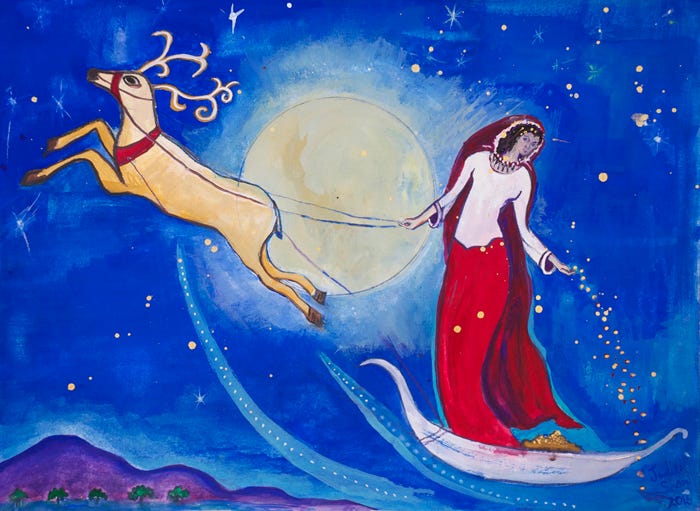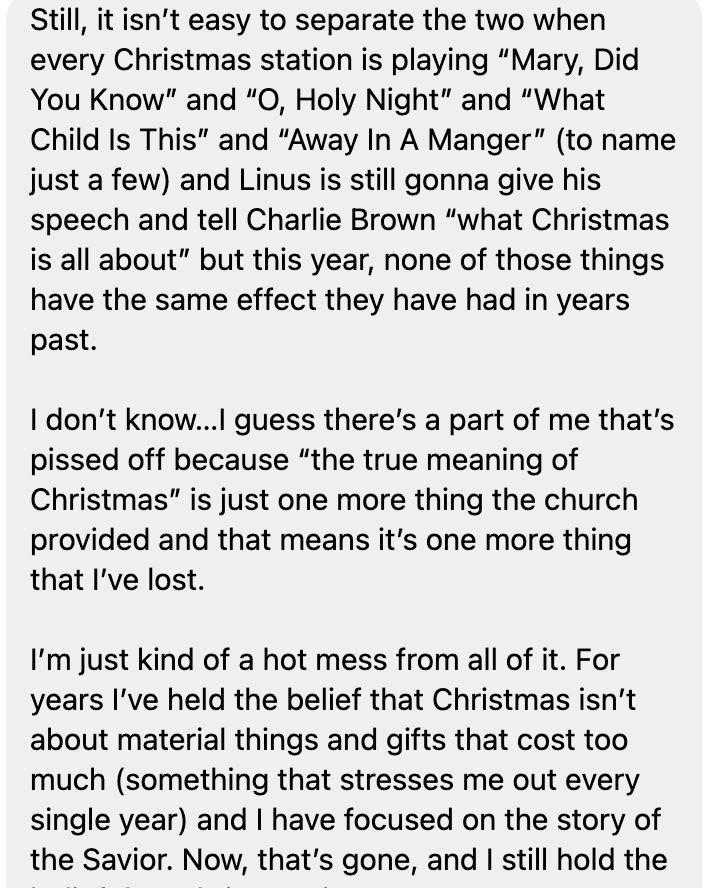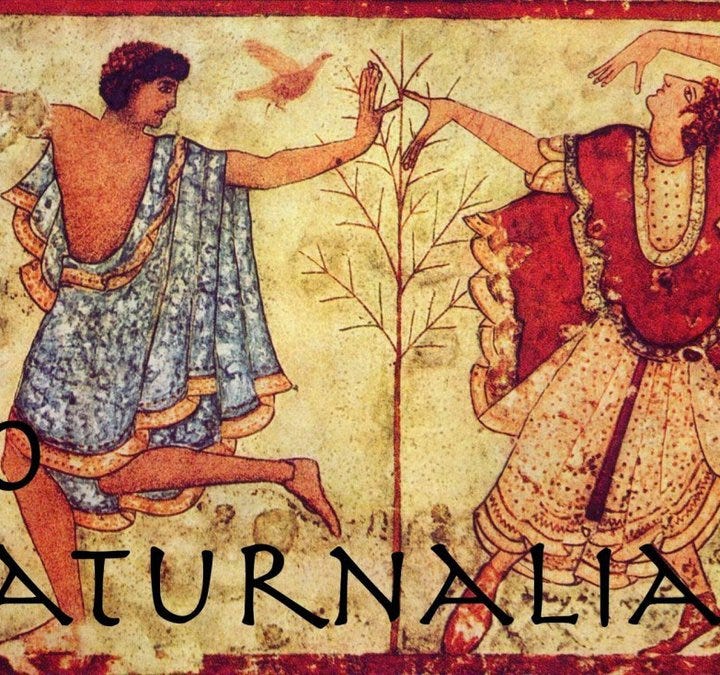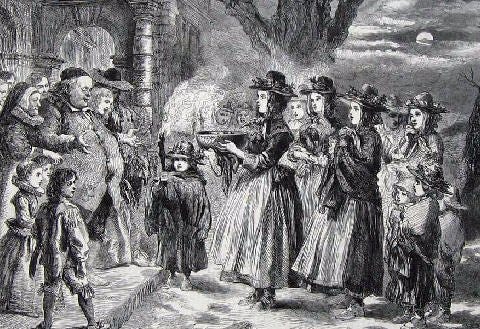What History Has to Say about the Reason for the Christmas Season (hint: it's not Jesus)
Trying to figure out how to do Christmas as a post-Christian? History says you are well within your right to carry on as you were.
I got the following DM this week:
The question “what do I do with Christmas now?” has come up in my spiritual direction sessions this month with just about everyone I meet with.
Today I’ll play the ghost of Christmas past as I take you on a journey that will hopefully leave you pleasantly surprised with how justified you are in carrying on celebrating as you always have. With perhaps just a little more emphasis on light and a little less on the son of God.
Turns out the origins of our most Christmas-y symbols and traditions have nothing to do with the Christ child.
What do I keep about Christmas?
We’ve been lied to about Christmas for a very, very long time. We’ve been told that Christmas started in 0 BC/AD in Bethlehem in the stable with the hay and shepherds and the babe in the stable.
This is false. Ancient civilizations all around the world have celebrated the winter solstice dating back far before Christianity took over Europe.
Come. Take my hand. Let us fly to Istanbul to begin our journey in the year 330 AD when December 25th was officially sanctioned as the celebration of the birth of Jesus.
Interesting that the celebration of the birth of Jesus began more than three centuries after the the birth of Jesus, no?
Well, turns out, not all that interesting when you consider what else was happening in 330. Constantine ruled the Roman Empire from 306-3371. Constantine had just barely declared Christianity as the official religion of the empire.
The most popular religion at this particular place and time was Mithras2. Interestingly, for them December 25th was Dies Natalis Solis Invicti - a holiday celebrating the “birthday of the sun” honoring the Sun God Mithra, who was amazingly also born of a virgin.
What are the chances?!
The winter solstice just ALSO happened to be a day of celebration for the Roman God Saturn, the Greek God Dionysis and the Norse God Beiwe.
What a coincidence Jesus was born on the same day!!
Excuse my sass, but instituting a celebration of Christ on December 25th was a very intentional move to demote existing pagan gods and promote the new god of the new religion, Jesus Christ.
Let’s check in with what different peoples were doing on December 25 before we celebrated Jesus on that day:
In Rome:
The solstice marked the last planting season for the Romans, and thus warranted a big week-long celebration called Saturnalia to pay thanks to the Roman god of agriculture- Saturn3.
The last day of the celebrations (you guessed it- December 25th) was called Brumalia and it was a day where social hierarchies were temporarily equalized and everyone from the nobility to the slaves came out for widespread merrymaking. Everyone wore colorful clothes and gambled and drank a lot (ya know, if you’re looking for new traditions….)
In Scandinavia:
Up in northern Europe, the Norse people held a 12 day festival around the solstice called Yule where the decorated a Yule tree, lit a Yule log, and ate a Yule ham since the boar was sacred to the Norse God Freyr. Yule was a celebration of the return of the Sun- a festival of rebirth.4
In Finland, the solstice meant celebrating the sun goddess Beiwe who rode on a sleigh pulled by reindeer.

In Greece:
Over in Greece, they were also partying for 12 days, but the cause of their celebrations was to honor the God of wine and festivities- Dionysus whose birthday happened to be on December 25 (such a trendy day to be born if you’re a god!).
They held huge feasts, got hammered, danced and exchanged gifts.

In the East:
Further east, the Slavs were celebrating Karachun where the shortest day of the year was marked with darkness and decay. But the next day the sun god was resurrected bringing light and hope to a dark world. Fires and feasts were prepared to celebrate the light.5
Despite Christianity being the “it” religion as early as 380, Christmas took hundreds of years to catch on. And even when the early Saints converted various peoples to Christianity, they were not at all eager to throw out their winter time holidays or traditions.
Even though Christian leaders like Tertullian, St Augustine and Pope Leo kept asking them to so nicely!6
Throughout the middle ages and well into the Renaissance, various pagan winter solstice traditions were carrying on all throughout Europe. We weren’t left with Christmas as we know it today- trademark CHRISTIANITY- until well into the 19th century.
It wasn’t even made an official holiday in America until 1870! Before then December 25th was just another work and school day.
So if you want to celebrate December 25th as something other than the birth of Jesus- you are in very good historical company.
Now what specifically do we keep from our existing Christmas traditions if we no longer believe in Jesus? The good news is hardly any of our Christmas symbols or traditions originated with the Christ child. Let’s break it down:
The Tree
We have record of evergreen trees holding a special significance of eternal life all across the globe from ancient Egyptians to the Chinese.
The Druids believed trees were a gift from Mother Goddess. They would use oak trees with mistletoe to celebrate the wisdom of seasons.7

The Vikings believed evergreen trees were the sun god’s favorite plant. While other trees lost their green leaves, evergreens served as a reminder of resilience- that winter would end, spring would come and the world would turn green again.
A rather lovely cause for celebration, no?
The Christmas tree is in fact only very recently deemed acceptable by Christianity. Up until the mid-19th century decorating a tree in your home was condemned as a pagan practice, specifically to celebrate Yule. In Northern Europe, people would bring felled fir trees into their homes and decorate them with candles to celebrate Yuletide.
Fun fact! Tree cutting for decoration is even condemned in the Bible. Jeremiah 10:2-4 cites cutting down trees as heathen idolatry. A fun little tidbit to pull out around your family!
Ornaments
While the Norse popularized the Christmas tree, we have Germany to thank for ornaments.
In order to entice tree spirits to return and bring spring, the Germanic people would make tiny wooden carvings of the gods, food and other symbols of spring. They would then place their creations right on the trees.
The evergreen trees and their ornaments were thought to bring good luck to the upcoming farming season.
Gift Giving
Christianity can hardly claim ownership over gift giving, as gifts are a staple in most of the festivities mentioned above. During their Saturnalia festivities, the Romans gave each other small gifts for good luck for the upcoming harvest.
Carolling
Again, singing is associated with many festivals across the globe, but we have the Saxons to thank for the winter tradition of door-to-door singing or wassailing. Neighbors would go singing to different houses to ward off bad spirits and bad health. “Waes hael” means “good health.”
Wassailers would often carry a spiced mulled ale with them, hence the shared name with the drink wassail (history is fun!).
Carolling has a much longer history associated with Christianity than the Christmas tree. There is record of St Francis taking inspiration from the wassailers way back in the 13th century.
Holly
Holly has such a cool history. When Christianity started to take over Rome, the Romans did not want to give up their Saturnalia celebrations. Holly was sacred to them as it symbolized Saturn the god of agriculture.
So pagans would decorate their houses with holly boughs and wreaths appearing as though they were celebrating Christmas, but really it was a secret symbol so they could recognize each other in the midst of their Christian communities.8
Holly is like a sneaky undercover agent plant.
Mistletoe
Kissing under the mistletoe also originates from the Romans, although mistletoe held a sacred significance to both the Celts and the Norse and was used in their winter festivities as well.
But for the Romans mistletoe was a sacred plant of fertility, and they would perform fertility rituals underneath it to boost both their own fertility and that of their upcoming harvest. (Fertility rituals are exactly what you’re thinking, so kissing is a tamed down version. Feel free to bring back the original!)
………………………………
So what do you have to give up to celebrate Christmas without Christ?
Not much!
Next week I’ll go more into specific ideas for new rituals and meanings.
Today, I just wanted to say that if you’re not celebrating the birth of Jesus in December- perhaps you feel alone on your block or in your family, but you’re in the company of most humans for most of not just ancient history but recent history as well.
And if you are celebrating the changing of the seasons, the advent of more light in the world, longer days, shorter nights, resilience, earth’s bounty, hope and rebirth you are in far greater company than those just celebrating Jesus.
Tell us- is Christmas time difficult for you if your beliefs have shifted? Have you found satisfying replacements for meaning and traditions?













Oh, how I needed this!! Thank you for your wisdom. Your weekly posts are so healing…balm for my soul!!
My husband and I left the church earlier this year. We’re still trying to figure out where (if) Jesus fits into our lives, and it has been difficult as we head into the holiday. This year, we’re just trying to focus on all the other things that we love about the season…it really helps to know that most of the things we love are not really Christian things at all. 🎄😊